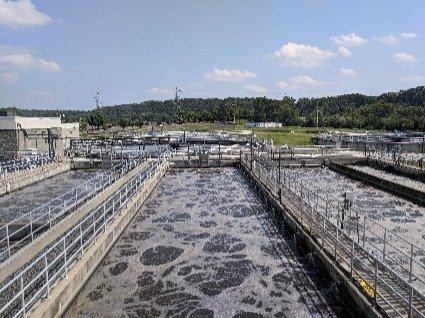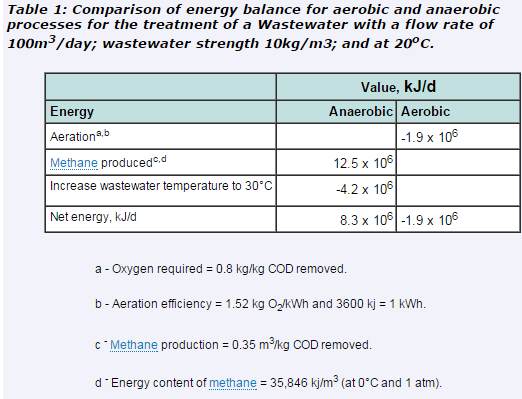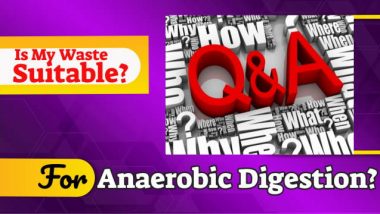The principal advantages and disadvantages of anaerobic wastewater treatment when compared with the aerobic equivalent processes are listed, and then discussed below.
Advantages of Anaerobic Treatment
 Less energy required
Less energy required- Less biological sludge produced
- Lower nutrient demand
- Methane production:
- Providing potential energy source with possible revenue both from the sale of the energy, and benefit from government tax breaks, and (Paris Accord 2015), CDM, etc. payments arising from renewable fuels/non-fossil fuel incentives
- Anaerobic digestion contributes to reducing greenhouse gases by reducing demand for fossil fuels
- Biomass acclimatization allows most organic compounds to be transformed
- The output can be potentially saleable products: biogas, soil conditioner, and liquid fertiliser (digestate) which may also be dried using AD process heat, to provide a crystalized digestate.
- Effectively provides sanitisation/removal of diseases after pasteurisation
- Odour when digestate is spread, is less intense during spreading than the smell from manure and slurries when deposited on land. Studies have shown that the duration of odor is also reduced.
Disadvantages of Anaerobic Treatment
Here is our list of the advantages and disadvantages of anaerobic wastewater treatment:
- Longer start-up time to develop necessary biomass inventory than for aerobic treatment
- May require alkalinity and/or specific ion addition
- May require further treatment in an aerobic treatment process to meet discharge requirements
- Biological nitrogen and phosphorus removal is not possible
- Much more sensitive to the adverse effect of lower temperatures on reaction rates
- May need heating (often by utilization of process gas as a sacrificial load) to achieve adequate reaction rates
- May be less stable after ‘toxic shock’ than an aerobic process (eg after upsets due to toxic substances in the feed or incorrect operation)
- Increased potential for production of odours and corrosive gases if the rotting feedstock is stockpiled in the open
- Hazards arise due to the potential for methane explosion. (In the EU, such additional Health & Safety Regulations as the ATEX Directive, and possibly also Gas Institute Regulations will require various compliance measures to be applied for AD.)
- Anaerobic treatment is not effective for the treatment of methanogenic landfill leachate, it may (rarely) be efficacious for the early stage leachate production period while the waste is still acetogenic.
Further Discussion of the Advantages of Anaerobic Treatment Processes

Of the advantages cited in the bullet points above, energy considerations, lower biomass yield, fewer nutrients required, and higher volumetric loadings are usually considered the most important, and are examined further in the following discussion.
Energy Considerations
Anaerobic processes may be net energy producers instead of energy users, as is the case for aerobic processes. This is a major advantage.
Table 1: Comparison of energy balance for aerobic and anaerobic processes for the treatment of a Wastewater with a flow rate of 100m3/day; wastewater strength 10kg/m3; and at 20oC.
For the conditions given, the aerobic process requires 1.9 x 106 kJ/d. On the other hand, the anaerobic process produces a total of 12.5 x 106 kJ/d.
Of the total energy produced anaerobically, about 4.2 x 106 kJ/d is required to raise the temperature of the wastewater from 20 to 30°C, the low end of the mesophilic temperature range, a more desirable temperature for anaerobic treatment. Thus, the potential net energy production that can be achieved with anaerobic treatment is on the order of 8.3 X 106 kJ/d.
This is a very significant benefit of anaerobic digestion treatment, especially when the pressing need for the reduction in fossil fuel use due to the severe consequences of current predictions of impending climate change. The summary of the 3rd UNFCCC Climate Change report reinforces this point, usefully when assessing the advantages and disadvantages of anaerobic wastewater treatment.

The wastewater strength is important for comparing energy balances for aerobic and anaerobic processes, where the wastewater temperature must be increased.
With the same assumptions used to generate the energy balance presented but with reducing COD present at some point as the concentration reduces, both the aerobic and anaerobic processes would require the same amount of energy input. At lower COD concentrations than this, the aerobic process requires less energy than the anaerobic. However, heat recovery from the anaerobic effluent stream can modify these values. Further, the lower biomass yield (lower sludge mass-produced in the effluent) as discussed below may still be a significant factor in favour of anaerobic treatment.
Advantage of the Lower Biomass Yield (Sludge) From Anaerobic Treatment
Because the energetics of anaerobic processes result in lower biomass production by a factor of about 6 to 8 times, sludge processing and disposal costs are reduced greatly when compared with the aerobic alternative.
The major environmental and economic issues associated with the reuse and disposal of biomass produced from aerobic processes are discussed in the book; Metcalf & Eddy, McGraw Hill ‘Wastewater Engineering, Treatment & Use”.
The fact that less sludge is produced in anaerobic treatment is a significant advantage over aerobic treatment.
Fewer Nutrients Required
Many industrial wastewaters lack sufficient nutrients to support aerobic growth. If so, the cost of nutrient addition is much less for anaerobic processes because less biomass is produced.
Higher Volumetric Loadings
Anaerobic processes generally have higher volumetric organic loads than aerobic processes, so smaller reactor volumes and less space may be required for treatment. Organic loading rates of 3.2 to 32 kg C0D/m3/d may be achieved which compares with 0.5 to 3.2 kg C0D/m3/d for aerobic processes.
Disadvantages of Anaerobic Treatment Processes
Disadvantages of anaerobic treatment processes vs aerobic treatment include:
- Higher capital and operating costs
- The visual impact of large digester units.
Operational Considerations When Comparing Aerobic Versus Anaerobic Treatment
Operational considerations, the need for alkalinity addition, and the need for further treatment are highlighted further in the following discussion.
The major concerns with the anaerobic process are:
the longer start-up time for AD processes based upon the slow growth rate of the methanogens needed to create biogas (months for anaerobic versus days for most aerobic processes).
- AD process sensitivity to possible toxic compounds, operational stability, the potential for odour
- The production, and corrosiveness of the digester gas introduce risks not present during aerobic treatment.
However, with proper wastewater characterization and process design, these problems can be avoided and/or managed.
Need for Alkalinity Addition
A most significant negative factor that can affect the economics of anaerobic versus aerobic treatment is the possible need to add alkalinity. Alkalinity concentrations of 2000 to 3000 mg/l as CaCO3 may be needed in anaerobic processes. They may need a chemical addition to maintain an acceptable pH with the high gas-phase COD concentration.
If this amount of alkalinity is not available in the influent wastewater or cannot be produced by the degradation of proteins and amino acid, a significant cost may be incurred to purchase alkalinity, which can affect negatively the overall economics of the process.
Pilot studies on feedstocks can be used to assess alkali dosing requirements, before the design stage of plants.
Need for Further Treatment After AD Treatment for Watercourse Discharges
Anaerobic processes can also be followed by aerobic processes for effluent polishing to utilize the benefits of both processes.
Series reactors of anaerobic-aerobic processes have been shown feasible for treating municipal wastewater in warmer climates resulting in lower energy requirements and less sludge production (Goncalves and Avanjo, J999; Garuti et al., 1992)
Conclusion
Let us now conclude on the advantages and disadvantages of anaerobic wastewater treatment.
In general, for municipal wastewaters with lower concentrations of biodegradable COD, lower temperatures, higher effluent quality needs, and nutrient removal requirements, aerobic processes are favoured at present.
What is undoubtedly highly favourable to the AD process is the Anaerobic Digestion of sewage works sludge produced as a product of the aerobic treatment as a first stage.
For industrial wastewaters with much higher biodegradable COD concentrations and elevated temperatures, anaerobic processes can be more economical than aerobic alternatives.
See also “the Environmental Benefits of Anaerobic Digestion” here.



There are lots of advantages over aerobic, you say. Why isn’t everyone doing it! something’s not right?